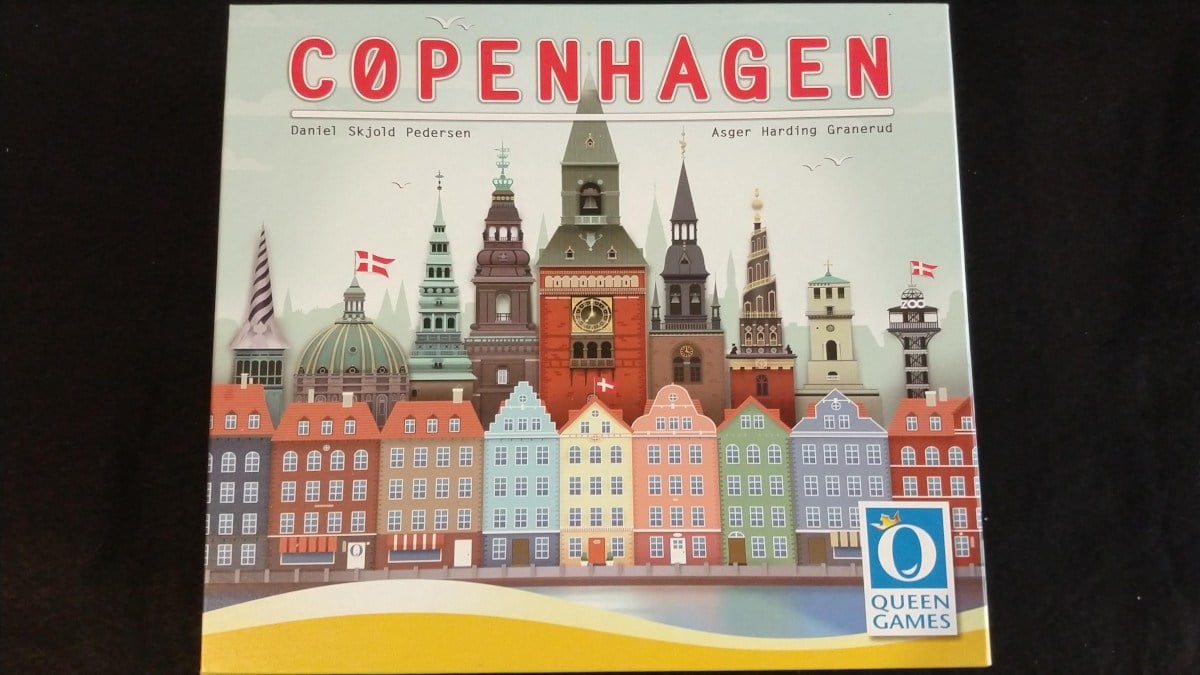 The more games I play the more I realize I don’t like to play what I thought I liked to play. Growing up, I always enjoyed sprawling strategic games that took hours to play and had big thick rulebooks. As I’ve grown older, perhaps because of time and space constraints, I’ve discovered that I need simple rules that allow strategic depth, without taking too long to finish. If it looks good too, so much the better. Step up then, Copenhagen by Queen Games. A quick-to-play, tactical conundrum that looks amazing and plays in around half an hour. Copenhagen is most definitely GeekDad Approved.
The more games I play the more I realize I don’t like to play what I thought I liked to play. Growing up, I always enjoyed sprawling strategic games that took hours to play and had big thick rulebooks. As I’ve grown older, perhaps because of time and space constraints, I’ve discovered that I need simple rules that allow strategic depth, without taking too long to finish. If it looks good too, so much the better. Step up then, Copenhagen by Queen Games. A quick-to-play, tactical conundrum that looks amazing and plays in around half an hour. Copenhagen is most definitely GeekDad Approved.
What Is Copenhagen About?
“Nyhavn” (New Harbor) in Copenhagen is famous for its colorful houses that sit along the waterside. In Copenhagen, the players try to emulate the classic windowed facades by building rows and columns of colored windows. It’s a strategic resource management game for 2-4 players aged around 10 upwards.
Each player collects different shaped “facade tiles” from a central repository and tries to arrange them on their house playboards. Each time a player constructs a row or a column on their house they receive victory points. If the row or column consists solely of windows they score double the points for those made out of bricks and windows. The window tiles are double-sided and shaped in a similar fashion to Tetris tiles, giving an array of possible arrangements.
Whoever has the most victory points at the end of the game, either when one player reaches 12 points or the “end of game” card is revealed, is the winner.

What’s in the Copenhagen Box?
- 1 Scoring Track.
- 1 Harbor Tile.
- 4 houses in 4 colors. 1 for each player. These are where players will place their window tiles.
- 4 Scoring Markers in the same color as the house colors above.
- 62 Facade Tiles. The meat of the game. These tiles represent the bricks and windows of the fronts of the building. They come in an array of shapes and 4 different colors. Each facade tile is a minimum of two squares and a maximum of 5. NOTE: The color of the facade tiles collected bears no relation to the color of a player’s playboard.
- 70 Facade Cards. Used to pay for facade tiles.
- 12 Special window tiles. Made to make building easier.
- 20 Ability Tiles. These are hard-earned. Use them wisely.
- 1 End of Game Card. Used to randomize the game’s end.

How to Set Up a Game of Copenhagen.
The harbor and scoring track are placed in the center of the table.
The facade tiles are stacked together, grouped by color and size. e.g. All the purple tiles are collected together and then organized into 2,3,4 & 5 sized pieces (Note: In a 2 or 3 player game some pieces are left in the box.)
The facade cards are shuffled and placed face down on the harbor. This is the game’s card supply.
The harbor card has 7 footbridges leading from it. Place 1 facade card from the pile, face-up, next to each bridge.
Choose a color and corresponding score marker.
Take 1 type of each ability tile per player, an place them (organized by type) next to the harbor. Each player takes the “Any Cards” ability tile.
Each player draws a starting hand. The exact number of cards varies, depending on how many players and which player you are, but this will be between 2 and 4 cards, with the starting players only ever getting 2.
You’re now ready to start.

How to Play Copenhagen
On each turn, you can do one of two things: either take cards or construct your facade.
Cards are taken from the face-up cards in around the harbor. You must take 2 cards. (Unless you are using an ability tile that allows you to take more.) You may never take fewer than 2. The cards taken must be adjacent to each other around the harbor.
You then refill the face-up cards from the supply deck.
You may never have more than 7 cards in your hand. If drawing cards means you would end up with more than 7, you must immediately discard cards back down to 7.
Constructing a Facade
To construct a facade you take a facade tile from the supply. To do this you play cards from your hand following two rules.
- The number of cards you play must match the number of squares on the facade tile you wish to take.
- All facade cards must be the same color as the facade tile that you want to pick up, e.g., to take a 3-squared red facade tile, you must discard 3 red facade cards.
There is an exception to the above. If you are placing a facade tile on your board that is touching a previously placed piece of the same color, you can discard one less card.
Once you’ve discarded your cards, you pick the facade tile you want and place it on your board according to the following rules.
- The tile may be rotated in any orientation but it must fit wholly in your grid without overlapping the edges or any previously placed tiles.
- It must be placed on the bottom row or such that at least one square is directly above a previously placed tile. If you imagine your grid like a Tetris board, your tile can’t hover in the air, unsupported. Unlike Tetris, it is possible to place tiles beneath existing tiles in the grid, as long as you don’t break either of the two placement rules.

Scoring
There are two ways to score, either by completing rows or columns. If you finish a row that consists of bricks and windows you get one point. If your row consists of only windows you score two points. Columns of bricks and windows score two points. Columns of only windows score four points. If a player reaches 12 points they win the game.
“Coat of Arms” Actions
If you complete a row or column that contains a coat of arms (a shield on the building card), you can perform one of three special actions.
- Take a special tile. These are single window tiles, which can be great for plugging awkward holes in your facade.
- Take an ability tile. The game has 4 special ability tiles, which each player can collect one of (no player can take the same ability tile twice). You can activate an ability at any time during your turn. Doing so deactivates it.
- Reactivate ALL your abilities. Abilities are super useful, but can only be activated once before you have to reactivate them. Reactivation happens to all your ability tiles at once, so choose your time wisely!
Ability Tiles
Well-timed use and reactivation of your ability tiles is the key to success in Copenhagen. They are powerful effects that can swing the game in your favor. The ability tiles are as follows:
- Any Cards: If you play this ability tile (and everybody starts with it) you don’t have to take cards from adjacent bridges; you can take any cards from the harbor.
- Additional Card: Use this to take an additional card. (Note: this does not have to be adjacent to the other two cards you picked up.)
- Construction discount: When constructing your facade, pay one less card for it.
- Change of colors: You may count one color of card as another color of card. Got 2 red and 3 blue? Count them as 5 red OR 5 blue!
- Both actions: Take cards AND build a facade on one turn.
NOTE: You can use as many ability cards as you like. So in theory you could use the “Any” card to pick up any two cards, the “both actions” card to be able to build something, and the “construction discount card” to enable you to use one fewer card to pay for your facade tile.

And that is about it.
Play is fast-paced, once you get the hang of it. It doesn’t take long to take the cards and decide what you want to build. Games end when one player reaches 12 points or you reach the end of the supply pile for the second time. The first time you reach the end of the facade cards, you shuffle the discard pile and play again. Note: on the second play through, the “End of Game” card is placed randomly in the final ten cards of the supply deck. Nobody will quite know when the game will end. If the end game card is found, the winner is the person with the most points. In the case of a tie, the player with the fewest empty spaces on their building wins.
Why Play Copenhagen?
Copenhagen is a great game because it’s quick to pick up, fun, with lots of tactical depth. It’s filled with small decisions that all impact on your final score. There is an eternal balance of choices. You have to manage being able to take the pieces you want, with keeping an eye on what your opponent is after. You also have to manage your ability tiles too. The person who wins the game will most likely be the person who gets the optimum benefit from their abilities.
However well you manage things, the game is still filled with, “If only I still had a ______ tile,” moments. Timing the grabbing a coat of arms square when your abilities are exhausted is a great tactical challenge and often the key to success. What to do with your coat of arms special abilities is another great balancing act. Again this is a mechanic that is easy to pick up but has lots of depth in-game.
Copenhagen reminded me of Imhotep because of its continual balancing of current and future needs, though in Copenhagen the ability to mess with your opponent is less overt.

On top of the tactical—when to get which pieces—mechanic, you additionally have the challenge of visualizing how best to tesselate the tiles on your player board. I don’t think this aspect is as in-depth as the tile picking mechanic, but it adds an extra strand to the game, that is very different from the rest of Copenhagen’s play-style.
The game itself is a thing of beauty. It looks amazing. The pieces are all of good quality; I love the house boards and the box art.
Overall, I’m extremely impressed with Copenhagen. It’s a great family game that you won’t have to spend ages explaining how to play and doesn’t take so long to get through that the children have to go to bed before they’ve finished their game. Copenhagen is fully GeekDad Approved.
![]() To subscribe to GeekDad’s tabletop gaming coverage, please copy this link and add it to your RSS reader.
To subscribe to GeekDad’s tabletop gaming coverage, please copy this link and add it to your RSS reader.
Click here to see all our tabletop game reviews.
Disclosure: GeekDad received a copy of this game for review purposes.





